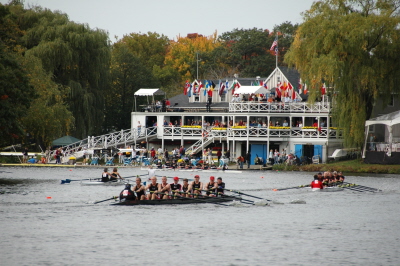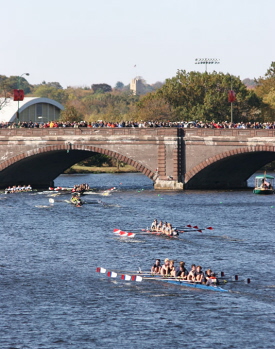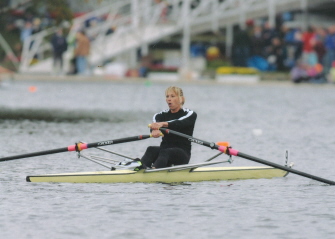Cheer on the Charles!
By Susan Farewell

For some 8,000 +/- rowers around the globe, the third weekend in October is something they've been working up to for months: the world’s largest annual two-day rowing event, the Head of the Charles Regatta on the Charles River which separates Boston and Cambridge, Massachusetts. These college-town sister cities always seem to have a tipsy air of carnival, but the ante is really upped on this weekend every October.
The annual regatta, now looking ahead to its 49th year, is hugely exciting not only for the participants but for the spectators who crowd the shores to watch world-class rowers from nearly two dozen countries muscle their way through a winding three-mile course (navigating through the arches of seven bridges) to beat one another’s crews by fractions of seconds.
“The Charles,” as the regatta is referred to by the rowing community, is a head race. This means that the boats (known as racing shells) are racing against the clock, traveling single file over the course. Once an event gets started, they are sent off fifteen seconds apart. From the banks and bridges of the river, you can watch all sorts of dramas unfold such as eight-person boats battling to pass one another as coxswains direct their rowers in Dutch, Turkish, maybe Mandarin. There are commentators along the course identifying the various oarsmen and women and revealing jaw-dropping facts such as “so and so is 88 years old” about the turbo-fit guy you watch loping along in a single.
Every year, there are nearly 2,000 boats registered to race in events broken up by age, sex, weight, and boat size and type. Ages range from early teens to late eighties. Some rowers are scullers (using two oars to propel their boats), while others are sweep rowers, holding one oar a piece with both hands.
At the Start
The very first Head of the Charles took place on October 16, 1965. It was established by Cambridge Boat Club members D’Arcy MacMahon, Howard McIntyre and Jack Vincent, with the assistance of Harvard University sculling instructor, Ernest Arlett, who proposed that a “head of the river” race similar to those in his native England, be held. It was established by Cambridge Boat Club members D’Arcy MacMahon, Howard McIntyre and Jack Vincent, with the assistance of Harvard University sculling instructor, Ernest Arlett, who proposed that a “head of the river” race similar to those in his native England, be held.
Jim Dietz, Head Women’s Crew Coach at the University of Massachusetts, has raced in the regatta every year since it started with the exception of one. A high school rower when he first entered the race, he said that back then, it was a simple two-hour Sunday morning event with about 100 competitors, all single scullers. “To time the boats, they had one twelve-inch Seth Thomas clock at the start and one at the finish,” he remembered. The officials took Polaroids of the start and finish times, and extrapolated the results by looking at the pictures. Telephones were used to coordinate the starts and finishes.
In the years since, the regatta has been growing rapidly not only with rowers, their coaches, family members and friends, but with 1,000 plus volunteers who are eager to be part of the excitement whether it’s helping launch boats or being umpires on the river.
It has also become one of Massachusetts’ most popular spectator events, right up there with Red Sox games and the Boston Marathon attracting dozens of sponsors. On a good weather Head of the Charles weekend, there can be as many as 300,000 people crowding the shores and lining the bridges, waving university flags and ringing cowbells. Many of the boathouses along the river, including Harvard’s Weld Boathouse and the Cambridge Boat Club, spill over with alumni, rowers and their supporters, who been looking forward to this event since the previous fall. There are also several riverside attractions open to the public including a fitness expo where you can try out the newest incarnation of rowing machine and other sports equipment, get up-close looks at racing shells, shop for HOCR memorabilia and feast on New England clam chowder in hollowed-out bread (among other goodies).

The Head of the Charles has grown so big that back in 1997, the regatta committee turned it into a two-day event. “We were turning away as much as 50% of the rower applicant pool,” explains the regatta’s executive director, Frederick V. Schoch, who has been spearheading the event for almost 20 years now. Today, while anyone can row in the Head of the Charles, there is an entry process, which includes a lottery for most of the events. Over thirty percent of the applicants are turned away, many due to space limitations. Returning crews are guaranteed entry if they were in the top fifty percent of their field in crew events or within five percent of the winning time in sculling events in the previous year.
Getting Ready
In addition to intensive training (which can include hours on the water and in the gym for months), prior to racing, rowers study the course as best they can. This is one race you don’t want to show up not having done your homework for. For locals, that means practicing on the river itself day after day. For out-of-towners, there are maps and course videos available. Some rowing clubs and school teams prepare their rowers with presentations providing detailed directions on how to effectively navigate the course. One organization, the All-American Rowing Camp, runs a camp weekend designed specifically to prepare for the Head of the Charles.
But no matter how prepared the rower may be, there’s no telling what can happen on the river on the day of the race. Sunshine or snow. Flat water or near white-caps. Collisions and near-misses. It’s all part of the great tradition and being part of it is a life-long goal for many a rower and a treat for many a spectator.
Photos provided by the Head of the Charles.
|
|
|

